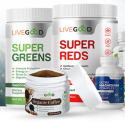Get Results with A-B split testing. Here’s info on how to split test a website. You’ll be amazed how a lot of small changes will lead to a higher conversion rate overall.
Fact is – MOST successful Internet businesses belong to people who are constantly testing and tweaking their sites, always on the lookout for changes they can make that will improve their results by even a tiny fraction.
That’s because, over time, these TINY improvements add up to BIG improvements… which lead to LOTS of additional profits in the bank.
And testing is SO easy to do, we’re shocked that so few people actually do it!
To run a test on your site, you just make a simple change (a new headline, for instance), and then keep a close eye on your sales. Do they go up? Then your headline is a winner, and you keep using it. Do they stay the same or go down? Then clearly that headline wasn’t so great, and you simply get rid of it.
Once that test is over, you test something else, either keeping or dumping that change depending on your results. And then something else… and something else…
See? Easy! In no time, you’ve conducted dozens of tests that, combined, will likely push your sales skyward… or finally help you break through your “no sales” slump, and start selling products like hotcakes!
So, if you haven’t been doing any testing with your website, TODAY is the day to start!
And while there are all kinds of things you can test on your website; we recommend you start with your sales copy. It’s one of the quickest ways to turn even the most sluggish website into a sales machine.
Here are six areas of your copy that you should be testing to improve your sales, along with the three golden rules of testing that you MUST follow in order to GUARANTEE good results:
1. Test Alternative Headlines
Make no mistake… your headline is the MOST important element on your website!
The stronger your headline, the greater your chances that a new visitor will stick around on your site long enough to buy something.
A good headline should GRAB your visitors’ attention, tell them — in less than 10 seconds — what the main benefits of your site are, what makes you better than your competition, and encourage them to read further, to find out more about what you’ve got to offer.
That’s a LOT of work for one single headline to do, so understandably, it can take a while to find one that accomplishes those goals effectively… and all at the same time!
So be sure you’re constantly testing new headlines, even if you already feel like your current headline is performing for you. You may surprise yourself and find one that improves sales even MORE.
But don’t just test the content of your headline…
Bear in mind that the Internet is a visual medium, and the way a headline looks can also have an impact on its success. So be sure to test other elements, like color, and for visual interest, consider bolding, highlighting, or italicizing the most important words.
2. Test Lower — And HIGHER — Prices
Here’s something that surprises people all the time: A price that’s too low can hurt sales just as much as one that’s too high!
The average online shopper has a “you get what you pay for” attitude, and will often feel that something with a low price mustn’t be very valuable… and therefore not worth having.
So be sure to do thorough price testing. By all means test prices lower than your starting price, but be sure to test HIGHER prices, too!
And remember, it’s possible to sell fewer units of your product at a higher price point, yet still earn MORE revenue, so when choosing a winner for your price testing, don’t just look at the number of sales.
Your price is one of the MOST important things you can test, because it has such an effect on your bottom line.
3. Test Your Site’s Main Body Copy
One painful truth about the website sales copy that you slaved over to get just right is that virtually NONE of your visitors will read it… at least, not word for word.
People who come online looking for information or products tend to scan webpages, rather than give them a close read.
So, to encourage your visitors to go through your copy from top to bottom, and at least pick out all of the major BENEFITS of your site and products, there are a number of elements you can test to make the copy more scannable.
Consider trying:
- Bulleted lists and subheads
- Emphasizing important points with bolding, highlighting, or italics
- Using a plain font like Arial or Verdana
- Including relevant graphics and images
- Plain backgrounds, including unpatterned, white, and light backgrounds
You should also test breaking up the copy into smaller chunks. Long blocks of heavy text look like too much work to read, and so people tend to ignore them completely, which will cost you sales. Your visitors should never have to work to find out what your product or service is about!
4. Test Your Overall Offer
Don’t confuse your “offer” with your price, or the product you’re selling. Your offer is actually the entire package you’re promoting, including incentives or bonuses.
To get maximum conversions on your site, you’ll want to try changing your offer by emphasizing different benefits, and trying out different bonuses.
If you’re selling a product using a long-copy sales letter, bonuses are a MUST.
But bear in mind that bonuses shouldn’t just be thrown onto the site as an afterthought. They need to be useful and relevant to your readers. The point of the bonuses is to add as much additional value to the offer as possible.
So, it’s a good idea, when possible, to test different bonuses on your site, to see if you can find some that provide the MOST value to your visitors.
Your benefits are also crucial to the success of your sales letter, so testing these is a very good idea. Your potential customers want to know how your product or service will make their lives easier. And you drive this home by focusing on benefits, not just features.
What’s the difference?
A feature is a particular highlight of a product or service, while a benefit is what the buyer actually gets from using the feature.
Attaching a benefit to the feature answers your visitor’s question: “What’s in it for me?” and gets them to imagine using your product to take care of the problem they’re trying to solve.
So, test different benefits within your sales copy (and headline) to find the ones that really click with your target audience.
5. Test Your Site Layout
Any good site statistics program will show you where your visitors enter your site, and where they exit.
If you find that most people are exiting your site from a specific page — without placing an order — you’ll want to do some testing of how your site is laid out.
Elements of your site layout that can affect your sales include:
- The position of your opt-in offer: test different places, or even try moving your opt-in offer to a Hover
- The layout of your site: test one, two, and three-column layouts
- The position of your navigation links: test placing them along the top or down the left-hand side of your page
- The prominence of your call to action: test a different size of text or bolding the call to action
By carefully testing these five copy elements on your website (your headline, pricing, body copy, offer, and layout), you can dramatically boost the conversion rates on your site…
… But BEFORE you dive in and start testing, there are a few basic ground rules for testing that you MUST follow, or you’ll either end up with results that aren’t meaningful, or HARM your site’s performance… or BOTH!
Testing Rule#1: Test one thing at a time
The key to successful testing is to quickly identify each new element that HELPS your conversion rates, and keep it, while figuring out which changes HURT your conversion rates, so you can get drop them right away.
But if you changed your headline, your bonuses, and your call to action all at once, how would you know which of these changes was making a difference (either good or bad)?
So, make sure you slowly and methodically go through your website, testing one element at time, monitoring the results carefully, and then either keeping or removing each change, before you move on to the next test.
In this way, over time, even tiny improvements will add up to a BIG increase in sales!
Testing Rule #2: Use a “control” as a benchmark to measure your test
Your control is your current best-performing sales letter, email, or other test subject.
For example, if a sales letter with a particular headline is currently generating a 2% sales conversion rate, your alternative headline tests should be measured against that control.
If, during testing, another headline generates a 4% conversion rate, you’ll keep that headline, and it becomes your new control. The next time you test headlines, you’ll try to beat that new one.
The aim is to use your tests to make continual improvements.
Testing Rule #3: Make sure you’ve got a level playing field
Ideally you should run tests within the same time frame to avoid skewing your results.
For example, you shouldn’t test one headline in September and another in December when seasonal factors could make a difference to your sales. Or, if you’re testing an email, you should send the two test emails to the same number of people to get a more accurate idea of which performs better.
The other important thing to remember is to always keep a record of your test results. You may find an old test one day that you thought should have done better than it did, decide to try it again and it works like a dream!
Once you’ve completed your tests, check out the corresponding statistics to measure your results.
The key numbers to keep an eye on include your bounce rate (number of people who leave the site again without visiting beyond your first page), number of visitors who reach your order form, and your sales conversion and opt-in rates. Then you can begin testing more elements!
The truth is, your job of testing never ends… and your sales copy is just the beginning of what you can test on your site to continually increase visitors, sales, and profits.
To increase your conversion rate, by learning how to split test a website, GO HERE to Grab a Free Copy of my Exponential Copywriting e-BOOK
Split-testing elements will bring you the success you seek!
Geoff Dodd, Editor in Chief, Online Course Business School, New Zealand.





